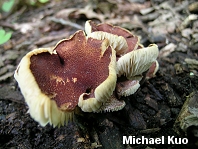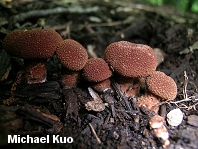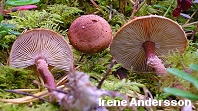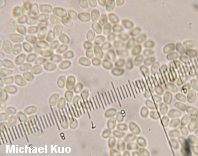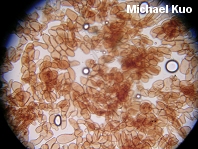| Major Groups > Gilled Mushrooms > Pale-Spored > Cystoderma > Cystoderma granulosum |

|
Cystoderma granulosum [Basidiomycetes > Agaricales > Tricholomataceae > Cystoderma . . . ] by Michael Kuo The colors of this species are extremely variable, but in most collections the cap and stem are tawny brown to brick red--or paler, when faded by sunlight. Like other species of Cystoderma, Cystoderma granulosum has a cap densely covered with granules which, as the mushroom matures, may begin to separate or wear away. There is no true ring on the stem, and the spores are inamyloid. The lack of a ring and the inamyloid spores will help to separate Cystoderma granulosum from other species in the genus, as will the lack of cystidia, and the presence of distinctive cells in the skin of the cap, which are chained together and have brownish to reddish brown walls when viewed in a KOH mount. Cystoderma cinnabarinum can look very similar, though it is usually larger, and more orange. It tends to favor conifers, and has prominent cystidia. Description: Ecology: Saprobic; growing scattered or gregariously under hardwoods or conifers, often on waste ground, moss, or barren places; summer and fall; widely distributed in North America. Cap: 1-5 cm; dry; at first convex with an inrolled margin, densely covered with conical granules and warts; in maturity broadly convex or flat, the granules sometimes less prominent; color ranging from tawny brown to brick red or cinnamon brown, occasionally orangish brown; often fading substantially when exposed to sunlight. Gills: Attached to the stem; close; whitish or yellowish. Stem: 2-6 cm long; up to 1 cm thick; equal; solid or hollow; dry; covered with granules and scales below, smoother near the apex; colored like the cap. Flesh: Whitish; not bruising. Odor and Taste: Taste mild; odor not distinctive. Spore Print: White. Microscopic Features: Spores 3.5-5 x 2-3 µ; elliptical; smooth; inamyloid. Cheilocystidia absent. Cuticular cells with rusty brown walls in KOH; chained together; variously sized and shaped. REFERENCES: (Batsch, 1783) Fayod, 1889. (Fries, 1821; Smith & Singer, 1945; Smith, Smith & Weber, 1979; Arora, 1986; Phillips, 1991/2005; Evenson, 1997; Barron, 1999; McNeil, 2006.) Herb. Kuo 05300404. This site contains no information about the edibility or toxicity of mushrooms. |
© MushroomExpert.Com |
|
Cite this page as: Kuo, M. (2004, August). Cystoderma granulosum. Retrieved from the MushroomExpert.Com Web site: http://www.mushroomexpert.com/cystoderma_granulosum.html |
